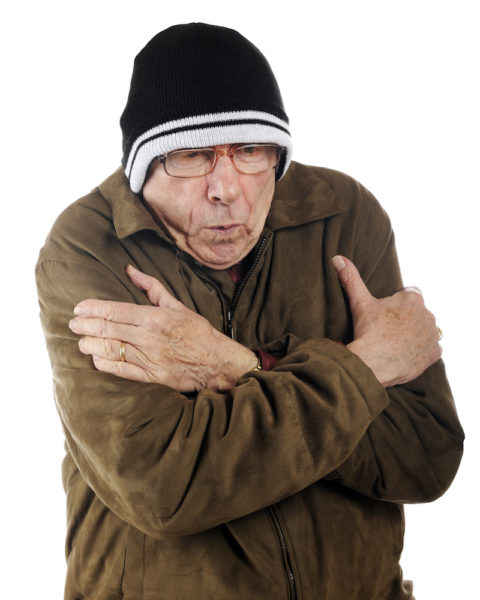Shivering is one of those amazing things our bodies do to keep us operating at top speed. It’s as if we had an internal thermostat. Too hot, we sweat in order to cool off. Too cold, we shiver to stay warm.
But did you know that as we age the thermostat doesn’t always work the way it should? Not good, especially in the kind of weather we’ve been experiencing lately, and one of the reasons why older people are at increased risk of developing hypothermia.
hy·po·ther·mia:
When the core body temperature is below 95°F. It occurs if the body loses heat faster than it can be produced. Severe hypothermia can be fatal.
Why older people are at risk for hypothermia
- Lower metabolic rate, which makes it more difficult to maintain a normal body temperature when the room temperature drops below about 65°F.
- Decreased ability to detect changes in the temperature.
- Decreased shivering and constricting of the blood vessels, which ordinarily helps maintain core body heat by diverting blood away from the arms and legs.
- Chronic medical conditions, such as diabetes, stroke, underactive thyroid, and Parkinson’s disease.
- Medications, such as antidepressants and sedatives, which may change how the body regulates temperature.
Important to know
Some elderly people may not be able to tell you they feel cold, may not be able to simply reach for a sweater or blanket or, especially if they have dementia, may not even realize it when they’re cold.
Something else to keep in mind is that what might seem too warm for a younger person may not be warm enough for an older person. Ideally, the thermostat should be set between 68°F and 70°F. Even just slightly lower can trigger hypothermia in a frail, elderly person.
Preventing hypothermia indoors
- Wear several layers of clothing.
- Wear long underwear, socks, and slippers.
- Wear a hat or a cap.
- Keep the thermostat at 68°F – 70°F.
- Drink warm beverages, but be cautious with alcoholic beverages because they can increase the risk.
- Check with a doctor about medication risks.
Warning signs of hypothermia in adults
- Confusion or sleepiness
- Slowed, slurred speech or shallow breathing
- Weak pulse
- Change in behavior or in the way a person looks
- Lots of shivering or no shivering at all; stiffness in the arms or legs
- Poor control over body movements or slow reactions
What to do if you suspect hypothermia
If you suspect someone has hypothermia, take his or her temperature. If it’s 96°F or below, the person needs medical attention right away. Call 911.
According to the National Institute on Aging, these are some things to do (and not do) while you’re waiting for help to arrive.
- Move person to a warmer place.
- Wrap in something warm — blanket, towels, coats. You can also provide warmth by lying next to the person. Don’t try to warm him/her in a bath. Don’t use a heating pad.
- Give the person something warm to drink, but no alcohol or anything with caffeine.
- Don’t rub the person’s arms or legs.
Heating assistance in Maine
People on a fixed income (like many elderly people) often worry about their heating bills and try to cut back.
A major source of heating assistance in Maine is the Low Income Home Energy Assistance Program (LIHEAP). For more information, visit either the Office of Community Services website or the Maine State Housing Authority website.
You can also call 2-1-1 to ask about heating assistance programs in your community or visit the 2-1-1 website.
If you’re aware of other programs that may help someone in Maine, please list them in the comment section below.
And when the temperature drops, remember to check on anyone you know who lives alone and/or may be at risk of developing hypothermia.


Hi Diane,
Thank you for your post about hypothermia. I am amazed at how low some people keep the thermostat in their homes and become used to it. I would find myself shivering a few times in homes even though I was dressed reasonably, and I dressed in several layers during subsequent visits. An elderly person might not do well under similar circumstances. In 2012 I posted a blog about keeping warm in winter while keeping the thermostat down and provided a link to it on this comment.
Also, this type of weather makes me more observant when I am walking on the street, making sure the people I pass are okay. Watching out for neighbors is important — especially during a power outage.
Warmest wishes,
Betsy
Thanks Betsy. I will read your blog post. I’ll also be talking about hypothermia on the News Center Morning Report tomorrow — crossing my fingers I’ll be able to get out of my driveway!